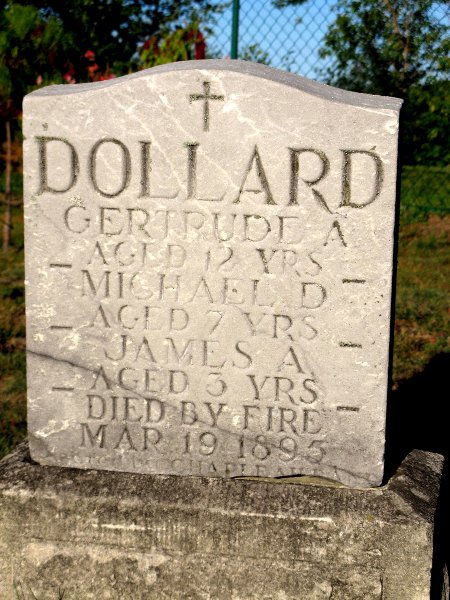
In the old Catholic Cemetery on the south side of Birch Street is a stone grave-marker with this inscription:
DOLLARD
GERTRUDE A.
AGED 12 YRS
MICHAEL D.
AGED 7 YRS
JAMES A.
AGED 3 YRS
The inscription goes on to state that all three �DIED BY FIRE, MAR. 19, 1895.� The stone was put up, interestingly enough, by the �CHAPLEAU BAND.�
Nothing else is known about this devastating loss to the tiny community of Chapleau, then barely ten years old. The disaster does remind us of a constant menace to people who lived in wooden structures heated by wood-burning stoves in a climate where the winters are long and hard.
Public buildings were just as vulnerable to fire as were private homes. In 1910, the Mechanics Institute, which had served as Chapleau�s first town hall, burned down, taking with it the town�s earliest library and a collection of memorabilia. Eight years later, on December 18, 1918, the old Sacred Heart Church burned to the ground.
Fire-protection became an issue as early as May, 1885, when a forest fire wiped out part of the new settlement. Vincent Crichton in his book, Pioneering in Northern Ontario, speculates that, when the CPR installed a pump house in 1886 to supply water to the steam locomotives and other steam-driven equipment, some kind of fire-fighting arrangement was made to protect both the CPR�s property and the village growing up around it.
The earliest documentary evidence for a fire department in Chapleau is an article published in a Sudbury paper in May, 1893, some two years before the fire that claimed the lives of Gertrude, Michael, and James Dollard.
One can only speculate, but the fact that the �birth of the present day Chapleau Fire Brigade occurred sometime about 1895,� suggests that its formation may have been a reaction to the Dollard tragedy. As the records of the early days of the Fire Brigade were lost when the Mechanics Institute burned down, we will probably never know.
The first home of the Fire Brigade was a shed on the lane that runs between Beech and Pine Streets, west of Young Street. This building was later moved down the same lane, to a location just off Lorne Street, on the south corner of the lot where Dr. Young�s Apartment Building now stands. At that spot, water was raised by a manual two-man pump from a well fed by an underground stream. A �small hand operated force pump located over a well� beside the site of today�s Village Shops was a second source of water.
Mr. Crichton records that when a fire occurred, volunteers tended to go to the fire, where all the excitement was, and leave the manual pumps under-manned. As a result, there could be moments of low or no pressure when unrelieved men at the pumps became exhausted.
In the early days, the town was alerted to an outbreak of fire by the frantic blowing of the CPR shop whistle and the clanging of the bell of the old Sacred Heart church. On these signals, the volunteer fire-fighters would run to the fire hall. According to Mr. Crichton, all the delivery boys in town, forgetting everything else, would race their horse-drawn carts to the fire hall, like so many Ben Hurs, seeking the honour of pulling the fire-fighting equipment to the fire. The first to arrive got $4 and the second got $2.
In 1910, two important developments took place: the fire fighters were formally organized into the Chapleau Fire Company, complete with a constitution and by-laws; and the municipality installed its first water works in the building that can still be seen amid the coils of the viaduct that crosses the CPR tracks. Fire hydrants and fire alarm boxes sprouted up around town.
A new fire hall was built in 1915, a wooden structure whose hose-drying tower was for a long time a landmark along Pine Street. (It was demolished in the late 1970s when today�s Civic Centre, Fire Hall, and Public Library were built on beside St. John�s Anglican church.)
In 1921 The Chapleau Fire Company acquired a second-hand model-T Ford truck. Unfortunately, the truck was not entirely reliable. In order to provide a back-up means of getting the equipment to the fire, the Council, after some hard bargaining, agreed to pay the delivery-cart boys the customary $4 and $2 just for showing up at the fire hall. If the model-T truck failed to start and the horses had to be used, the first and second horses got an additional $5 and $3 respectively.
The purchase of a dependable, albeit a second-hand, Reo fire truck around 1925 made the colourful race of the delivery carts to the fire hall unnecessary and closed the pioneering phase of fire-fighting in Chapleau.
Since then more and much better equipment and more intensively trained volunteer firefighters have provided Chapleau with excellent fire protection. Unfortunately, fires still break out and sometimes there are still fatalities. Sadly enough, the Dollard children were not Chapleau�s last victims of fire.
An article written by George Evans, based on material found in the book, Pioneering in Northern Ontario by Vincent Crichton.